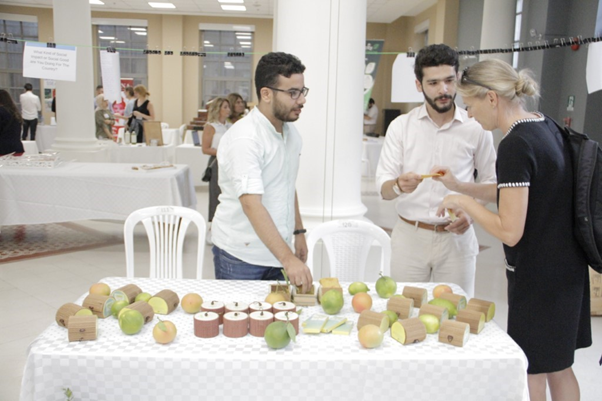WHAT IF... you created value by upcycling waste into valuable products?
Sourcing raw materials is often time-consuming and expensive for start-ups. In addition, environmentally oriented start-ups in particular hesitate to rely on the use of raw materials as it can have taxing effects on the world’s ecosystems, for example by relying on scarce resources from the natural world or on a material that is also used at scale for another purpose. In line with the saying “one (wo)man’s trash is another (wo)man’s treasure”, some entrepreneurs have taken to sourcing discarded materials and breathe new life into them by upcycling them into entirely new products. Often, this also allows them to significantly release the value of the material as part of a new product.
Turning challenges into opportunities
The World Bank estimates that the world generates roughly 3.5 million tons of solid waste a per day – a staggering figure that includes plastics, food waste, sludge, construction debris, among many others. At first glance, these discarded items appear to have run their course and the only job they now fulfil is adding an immense burden on our already heavily impacted environment.
On the other hand, start-ups in the production and manufacturing business face challenges when it comes to sourcing the virgin materials they require. Raw materials are materials or substances used in the primary production or manufacturing of goods, and they are often difficult or expensive to come by. Not to mention that due to an increasing environmental and social awareness, many start-ups want to avoid potentially hazardous, hard-to-recycle or endangered materials.
Especially with electronics or high-tech products, there is increased competition globally around certain virgin materials, many of which are marred with dubious extraction or sourcing practices – so-called conflict materials. At the same time, increased demand for consumer goods leads to products being discarded sooner and newer ones being replenished at a faster rate. Recycling standards are not always adhered to in many parts of the world. Many resources thus get lost and disappear in landfills, although they could very much still fulfil a purpose.
Entrepreneurs tap into these resources by sourcing them directly from others’ discarded items and increasing their value through clever production and manufacturing.
Regardless of the benefits of this strategy, you should take two main things into account when considering to pursue waste recovery and upcycling:
-
There is indeed competition around waste, especially waste of value in its unmodified form – for example waste pickers, who will often attempt to extract many items of value at an early stage.
-
Recovering materials can sometimes be challenging and complex and requires advanced technologies. The payoff can be worth it but needs to be assessed on a case-by-case basis in regard to cost efficiency, quality and safety.
Moving towards a strategy
One of the main benefits of the outlined strategy of sourcing raw material from waste and increasing its value through the production cycle is clear: Waste in different forms and variations can be easily acquired for free, very cheap or at least cheaper than the respective new raw material. In addition, and more importantly, pursuing this strategy will allow the start-up to proactively contribute to limiting the ever-growing amount of waste that is polluting the planet at present.
Replacing raw materials for recovered ones and re-integrating them into the production process gives a second life to what would have otherwise ended up in landfill, and helps to reduce greenhouse emissions and limiting environmental damage. The latter gives a great added benefit to socially minded start-ups, as it increases their credibility, value proposition and integrity towards their equally sustainably oriented customer base. And the benefits don’t end here – raw materials often burn through substantial amounts of fuel until they reach their destination, where they are finally processed (and then again, even more transportation is needed to reach the end customer). By sourcing waste locally, you can contribute to mitigating those long delivery chains.
What is important to note with this strategy is that the aim of the output should be increased as much as possible through the start-up’s business model – e.g. when collecting organic waste to produce compost, the end goal of the exercise should be to grow high-value flowers or herbs from compost that can be sold with a much higher profit margin.
Case Study 1
OrganyClean is a Lebanese start-up which is dedicated to providing green and sustainable hygiene products by using natural resources instead of chemicals. They also try to contribute to organic waste management by turning agro-waste (fruits/vegetables) into unique, new, valuable consumer products. In particular, they launched their operations by collecting discarded orange peels from fruit stand vendors and upcycling them into high-quality soap pads, thus allowing them to source a large share of the material they require for production for free. On the other hand, the value increases substantially through the final output.
OrganyClean’s environmentally conscious products can be marketed to a broad range of consumers. For example, they could appeal to eco-conscious customers who care about the ingredients of the products they consume, as well as provide a tangible, large-scale solution to waste problems caused by discarded sanitary wipes for childcare, and, last but not least, offer portable, biodegradable solutions for refugee camps and vulnerable communities which are often particularly hard-hit by mounting waste.

Mohammad and Abed, co-founders of OrganyClean, present orange peel soap pads at a networking event in Beirut. Source: OrganyClean.

